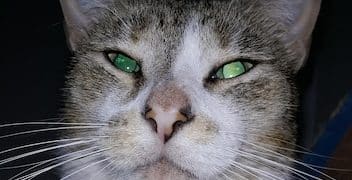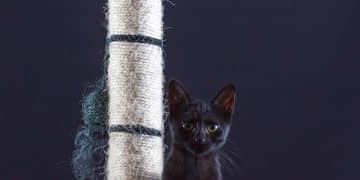Decoding Your Cat’s Body Language: A Visual Guide
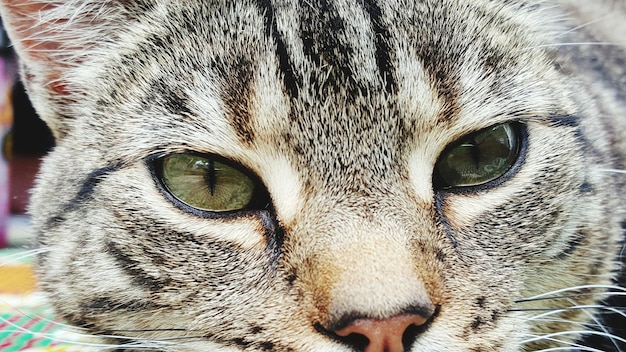
Decoding your cat’s body language involves understanding their subtle cues, from tail movements and ear positions to vocalizations and facial expressions, allowing you to better interpret their needs and emotions.
Do you ever wonder what your cat is trying to tell you? Felines are masters of subtle communication, and understanding their body language is key to building a stronger bond. This guide will help you decipher the secret language of your furry friend, providing valuable insights into their emotions and intentions.
Decoding Your Cat’s Body Language: A Feline Communication Guide
Cats communicate through a complex system of body language, vocalizations, and scent marking. Understanding these signals is essential for any cat owner who wants to truly connect with their feline companion. This guide provides an in-depth look at the various ways cats express themselves, helping you to better understand their needs and emotions.
From the subtle twitch of a tail to the intensity of their gaze, cats are constantly communicating with us. Learning to interpret these signals will not only strengthen your relationship with your cat but also help you to identify potential problems early on. So, let’s dive into the fascinating world of feline communication.
Understanding Tail Language
A cat’s tail is a powerful indicator of their mood and intentions. Here’s a breakdown of what different tail positions might mean:
- Upright Tail: This usually indicates happiness and confidence. Your cat is feeling friendly and approachable.
- Tail Twitching: A slight twitch can mean excitement or anticipation, like when they’re watching a bird outside the window.
- Puffed-Up Tail: This is a sign of fear or aggression. Your cat is trying to appear larger and more intimidating.
- Tucked Tail: This indicates fear or submission. Your cat is feeling anxious and vulnerable.
By observing your cat’s tail movements in conjunction with other body language cues, you can gain a more complete understanding of their emotional state.
In conclusion, observing the cat’s tail movements can give valuable clues to its emotional state. It is important to watch other signals, too, for a better understanding of the complete picture of the cat’s emotional condition.
Ears and Eyes: Windows to the Feline Soul
A cat’s ears and eyes are incredibly expressive, providing further insights into their mood and intentions.
The position of their ears, the dilation of their pupils, and the intensity of their gaze can all tell you a great deal about how your cat is feeling.
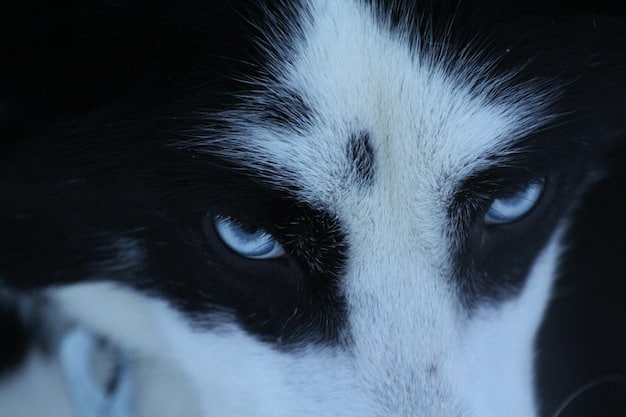
Here are some key things to look for:
Decoding Ear Signals
- Ears Forward: This indicates alertness and interest. Your cat is focused on something in their environment.
- Ears Back or to the Side: This can indicate fear, anxiety, or irritation. Your cat is feeling uncomfortable or threatened.
- Ears Flattened Against the Head: This is a sign of aggression. Your cat is preparing to defend itself.
Interpreting Eye Contact
- Slow Blinking: This is often referred to as a “cat kiss” and indicates that your cat feels comfortable and trusts you.
- Direct Stare: This can be a sign of aggression or a challenge. Avoid prolonged eye contact with a cat you don’t know.
- Dilated Pupils: This can indicate excitement, fear, or even playfulness. Pay attention to the context to determine the cause.
In summary, by carefully observing your cat’s ears and eyes, you can gain valuable insights into their emotional state and better understand their behavior. These signals, combined with other body language cues, can help you to build a stronger and more harmonious relationship with your feline companion.
Vocalizations: More Than Just “Meow”
Cats are known for their vocalizations, but each sound carries a distinct meaning.
While “meow” is the most recognized sound, cats use a variety of other vocalizations to communicate with their humans and other animals. Understanding these different sounds can help you to better interpret your cat’s needs and emotions.
Common Feline Sounds
- Meow: This is typically used to get your attention or to request something, such as food or affection.
- Purr: Usually indicates contentment and pleasure, but can also be a sign of self-soothing when a cat is injured or stressed.
- Hiss: A clear warning sign that your cat is feeling threatened or aggressive.
- Growl: Similar to a hiss, a growl indicates that your cat is feeling defensive and may be about to attack.
The Nuances of Vocal Communication
Beyond these common sounds, cats also use chirps, trills, and even yelps to communicate. The context in which these sounds are made is crucial for understanding their meaning. For example, a cat may chirp when they see a bird outside the window, indicating excitement and hunting instincts. A trill can be a friendly greeting, while a yelp usually indicates pain or fear.
To conclude, vocalizations provide another piece of the puzzle when it comes to understanding your cat’s communication. By paying attention to the different sounds they make and considering the context in which they are made, you can gain a more complete understanding of their needs and emotions.
Facial Expressions: Subtle Yet Significant
Cats have unique facial expressions that signal different emotions.
While not as overtly expressive as humans, cats use subtle facial cues to communicate their feelings. Paying attention to these cues can help you to better understand your cat’s emotional state.
Reading Feline Faces
- Relaxed Face: Soft eyes, relaxed whiskers, and a neutral mouth indicate contentment and relaxation.
- Tense Face: Tightly closed mouth, narrowed eyes, and forward-pointing whiskers can indicate stress or anxiety.
- Playful Face: Wide eyes, perked ears, and a slightly open mouth can indicate playfulness and excitement.
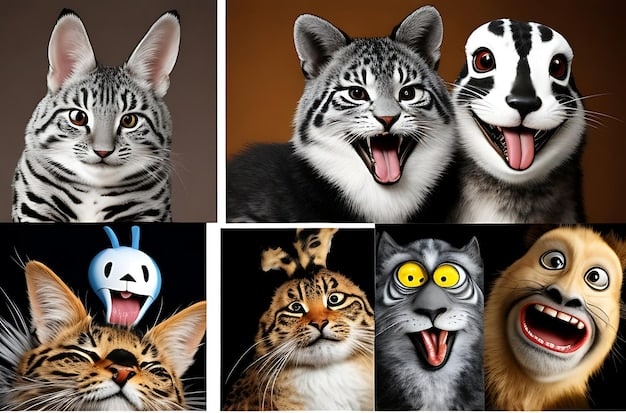
The Importance of Context
As with all forms of feline communication, context is key when interpreting facial expressions. A cat may narrow their eyes when they are feeling sleepy, or they may narrow their eyes when they are feeling threatened. By considering the surrounding circumstances and observing other body language cues, you can get a more accurate understanding of what your cat is trying to tell you.
In summary, facial expressions, though subtle, play a significant role in feline communication. Learning to recognize these expressions can help you to better understand your cat’s emotions and respond to their needs appropriately. Combining these observations with other body language cues will provide a more comprehensive understanding of their overall state.
Scent Marking: A Cat’s Olfactory Business Card
Cats use scent marking to establish territory and communicate.
Scent marking is a natural and important form of communication for cats. They use scent glands located on their cheeks, paws, and tail to leave olfactory signals that convey information to other cats. Understanding this behavior can help you to create a more harmonious environment for your feline friend.
Here’s how cats use scent marking:
Methods of Scent Marking
- Rubbing: Cats often rub their faces against objects or people to deposit pheromones from their cheek glands.
- Scratching: Scratching not only sharpens their claws but also leaves scent markers from the glands in their paws.
- Spraying: While more common in unneutered males, spraying involves releasing a small amount of urine to mark territory.
The Message of Scent
The scents that cats leave behind can communicate a variety of information, including their identity, their reproductive status, and their territorial boundaries. These scents can also provide a sense of security and familiarity for the cat. For example, when a cat rubs against you, they are not only showing affection but also marking you as part of their social group.
In conclusion, scent marking is a fundamental aspect of feline communication. Understanding this behavior can help you to appreciate your cat’s natural instincts and create a more supportive and enriching environment for them. By recognizing the ways in which cats use scent to communicate, you can better understand their needs and build a stronger bond with your feline companion.
Bringing It All Together: Context is Key
Understanding your cat requires considering all signals together.
Decoding your cat’s body language is not about isolating individual cues but rather about considering the entire picture. The context in which a behavior occurs is crucial for accurate interpretation. This means taking into account the cat’s environment, their past experiences, and their current emotional state.
The Importance of Observation
The best way to become fluent in feline body language is to observe your cat closely and consistently. Pay attention to the subtle nuances of their behavior and how they change in different situations. Keep a record of your observations and look for patterns over time. This will help you to develop a deeper understanding of your cat’s unique communication style.
Putting It Into Practice
Imagine your cat is sitting near the window, watching birds outside. Their ears are perked forward, their eyes are wide, and their tail is twitching. This combination of cues suggests that your cat is experiencing excitement and perhaps a bit of hunting instinct. On the other hand, if your cat is hiding under the bed with their ears flattened against their head and their tail tucked between their legs, they are likely feeling frightened or anxious.
In conclusion, understanding your cat’s body language is an ongoing process that requires patience, observation, and a willingness to learn. By considering all the available cues and paying attention to the context in which they occur, you can develop a deeper connection with your feline companion and better understand their needs and emotions.
| Key Point | Brief Description |
|---|---|
| 😻 Tail Position | Indicates mood; upright means happy, tucked means scared. |
| 👂 Ear Signals | Forward means alert, back means fear or irritation. |
| 🔊 Vocalizations | Meows seek attention; purrs mean content, but can also be self-soothing. |
| 👃 Scent Marking | Rubbing, scratching, spraying – to mark territory and communicate. |
Frequently Asked Questions
▼
Kneading is a behavior that cats develop as kittens when nursing. It is often associated with comfort and contentment. When your cat kneads on you, it’s a sign they feel safe and secure in your presence.
▼
A slow blink is often referred to as a “cat kiss.” It indicates that your cat trusts you and feels relaxed around you. It’s a sign of affection and a way for your cat to show they are comfortable in your presence.
▼
When your cat rubs against your legs, they are depositing pheromones from their cheek glands. This behavior is a way of marking you as part of their social group and claiming you as their own. It also provides them with a sense of security.
▼
A puffed-up tail is a sign that your cat is feeling threatened or frightened. They are trying to make themselves appear larger and more intimidating to ward off any potential danger. It’s important to give your cat space and allow them to calm down.
▼
A gentle bite, often called a “love bite,” is a way for your cat to show affection. However, it can also be a sign that they are overstimulated or want you to stop petting them. Pay attention to your cat’s other body language cues to understand the reason behind the bite.
Conclusion
By understanding these essential elements of feline communication, you can significantly improve your relationship with your cat, meeting their needs and strengthening your bond for years to come.
